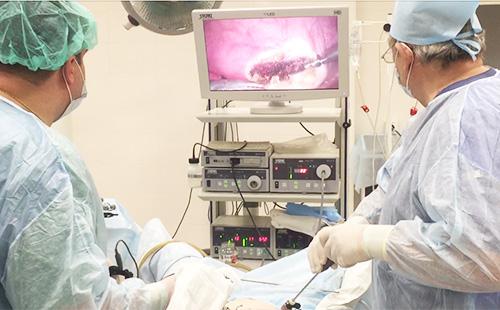The content of the article
For many, female sterilization is associated with a similar procedure in animals, particularly cats. After that, pets gain weight, become more passive and indifferent to others. But, despite similar terms, the essence of the procedures is different. In women, sterilization involves only ligation of the fallopian tubes with the preservation of all organs. In cats, the ovaries are removed during the sterilization process, often in combination with the uterus.
Reasons to allow sterilization
Considering the fact that surgical sterilization (tubal ligation) is a serious surgical intervention, its conduct is strictly regulated by law. In Russia, many are bandaged and tubal ligation is permitted in the following cases:
- after 35 years - regardless of the number of children;
- after 18 years - in the presence of two children;
- after repeated cesarean section - in the presence of living and healthy children;
- for medical reasons - on the part of the woman.
In order to perform sterilization, the written consent of the woman is required. According to medical indications, the operation is performed in the presence of mental illness, serious somatic pathologies in which pregnancy is contraindicated (for example, decompensated diabetes or grade III-IV hypertension), and malignant diseases in the past.
Features
Independent pregnancy in healthy women is possible if the egg meets the sperm and fertilization occurs. The female reproductive cell matures in the ovary, and the male enters with the sperm into the vagina and cervix. Fertilization occurs in 90% of cases in the fallopian tube.
Why are women bandaging the pipes and is it worth it? In order to exclude conception, during sterilization a mechanical obstacle is created in the way of the germ cells at the level of the fallopian tubes - they are cut, ligated or cauterized. The egg is regressed in the fallopian tube from the ovary or in the abdominal cavity. All other structures remain intact, therefore, no other changes in health, sex life are noted. In fact, tubal infertility in a woman is artificially formed.
According to the time of sterilization, the following options are possible:
- separately- as a separate operation;
- during cesarean section - as a stage of surgical intervention;
- after natural birth - on the fifth or seventh day or six weeks later.
With cesarean section
Typically, tubal ligation is performed with cesarean section. The benefits are as follows:
- no need for additional surgery;
- no additional examination is needed the day before;
- ligation of the fallopian tubes can be hidden from other people.
After cesarean section, you should think about a reliable method of protection for at least a half to two years to come.And if the couple does not plan replenishment or there are some medical indications (for example, thinning of the scar on the uterus, signs of placenta ingrowth in the old suture), sterilization is an ideal method of contraception.

Survey on the eve
Sterilization includes a full examination on the eve, except when it is performed during a cesarean section. The list is as follows:
- blood and urine tests;
- coagulogram;
- fluorography;
- blood tests for hepatitis, HIV, syphilis;
- ECG;
- therapist examination.
Anesthesia
Different anesthesia is used depending on the technique of the operation:
- laparoscopic- only intubation anesthesia with temporary mechanical ventilation (mechanical ventilation);
- laparotomy - spinal anesthesia (“an injection in the back”) or endotracheal anesthesia with mechanical ventilation.
Types of operations
Depending on the clinical situation, preference is given to one or another type of surgical intervention. Sterilization during cesarean section - as a stage of the operation. In other cases, the possible options are presented in the table.
Table - Sterilization Techniques
| Features | Laparoscopy | Minilaparotomy | Colpotomy |
|---|---|---|---|
| Equipment | Special instruments are placed in the abdominal cavity through 2-3 small incisions in the iliac regions and near the navel | An incision of the anterior abdominal wall is performed at 4-5 cm horizontally or vertically | Access through an incision in the vaginal mucosa |
| pros | - Minimum tissue trauma; - short rehabilitation period; - seams and scars are invisible | - It is performed even with an adhesive process and overweight; - the technique is simple; - do not need "non-standard" tools | - Less traumatic; - no marks on the body; - rehabilitation no more than a week |
| Minuses | - Not performed with severe adhesions, obesity; - special equipment and trained specialists are needed | - traumatic; - rehabilitation for at least 2-3 weeks; - a noticeable seam remains | - Not performed during adhesions; - possible technical difficulties |
A mechanical obstruction at the level of the fallopian tubes can be created in various ways:
- directly pipe ligation - while the fallopian tubes are pulled by non-absorbable suture material;
- moxibustion - the fallopian tube is cut into two parts using an electrode, more often used for laparoscopy;
- dressing and moxibustion - the fallopian tubes are ligated, then dissected and the ends are additionally coagulated;
- dressing and dissection - fallopian tubes are pulled by suture material, and then dissected;
- overlay clips - used for laparoscopy, while the patency of the fallopian tubes is impaired.
Contraindications
Contraindications to sterilization are due to limitations in pain management, as well as a high risk of complications in some conditions. Surgery in acute inflammatory diseases of the pelvic organs is excluded. The list of relative contraindications:
- cardiovascular diseases;
- tumors in the pelvis;
- diabetes;
- somatic diseases in the stage of decompensation;
- pronounced adhesion process;
- obesity III-IV degree.
Postoperative period
The severity of the postoperative period depends on the method of intervention. When performing an isolated sterilization (not during a cesarean section or other operation), a woman can be discharged home on the second or third day with the recommendations:
- physical and sexual rest - in two weeks;
- exclusion of visiting baths, saunas - within three weeks;
- postoperative wound treatment - according to the destination.
Possible complications
Complications that may arise:
- during surgery - bleeding, damage to the intestines, ovaries;
- after discharge — mental disorders, changes in the menstrual cycle and hormonal failure.
Advantages and disadvantages
Each woman takes the decision on the need for sterilization on her own. Advantages and disadvantages of the method are presented in the table.
Table - Pros and cons of tubal ligation
| pros | Minuses |
|---|---|
| - Effective protection against pregnancy; - looseness in sex; - savings on birth control pills or condoms | - Insecurity from genital infections; - psychological discomfort; - the inability to conceive without additional operations or IVF; - in 2% of cases, pregnancy still occurs |
Chances of Conception
Sterilization eliminates the possibility of independent spontaneous conception. Getting pregnant after surgery is possible only in the following ways.
- Microsurgery. Allows you to restore the fallopian tubes after dressing, dissection and cauterization, applying ligatures. The duration of the operation is at least two to three hours, a special microscope is required to conduct, allowing to distinguish structures less than 1 mm. Efficiency from 40 to 85%. Conventional laparoscopy cannot do this.
- Assisted Reproductive Medicine. Women after sterilization are similar to those who, for other reasons, developed tubal infertility. There are no obstacles to performing IVF, but this is an expensive procedure that requires a serious hormonal load on a woman's body.
Alternative
There are alternative methods of protection. They have the same efficiency as sterilization (about 99%).
- Hormone pills, vaginal rings, patches. Reliable, but have many contraindications, give side effects. They are not cheap. It’s sometimes difficult to pick up a drug. It is necessary to observe the reception schedule. A patch or ring needs to be replaced.
- Intrauterine device (IUD). It is installed for three to five years. Affordable method. But it does not suit some, because of which there are plentiful painful periods. It can not be installed with pathology of the cervix. IUD provokes inflammation in the uterine cavity.
Female sterilization is an effective and safe method of preventing pregnancy. Monthly, the patient’s general well-being and feelings during an intimate relationship after surgery do not change. The procedure is regulated by law - it is prohibited for girls under 18 years old and childless women under 35 years old.

Reviews
I myself wrote an application for tubal ligation during the second cesarean. I was then 27 years old. For our family, we considered this operation a necessity. Because I would not have survived the third pregnancy because of my health, it is extremely difficult for me to pick up contraception and my husband and I really love sex. Everything went well. While enjoying life. It’s just that all the doctors said that even after sterilization, there remains a chance of restoring fertility. Very rarely, but it happens.
The only thing that is not strong is the issues of the church and I don’t know how it relates to such things.
My lady http://www.kid.ru/forum/txt/index.php/t2384.html
According to my medical testimony, my tubes were bandaged during a cesarean section. Without any consent and signatures. I found out about everything the next day. When they brought a piece of paper to sign. At first she was very upset, but when the doctor explained everything to me popularly, she pulled herself together.
Neither on sex, nor on critical days (both walked and are walking), and did not affect health in any way. I feel great. My head doesn’t hurt, I don’t put on weight for contraception. Everything is usual, as it was before the dressing. I have two kids and a wonderful husband. I think only of the good.
Olka29, http://www.kid.ru/forum/txt/index.php/t2384.html
And at 25 I gave birth to a second child and my husband decided that everything was enough for us children. 8 years was protected by hormonal pills and ... flew in 33. They gave birth to another miracle. We are not overjoyed. But six months after the birth (all ER), she went to a paid clinic and was sterilized. Spouse was not asked for consent. Yes, he would not have known if she had not said so. No visible scars, sex - a complete fly away. Some positive aspects.
Mayan, http://www.woman.ru/health/woman-health/thread/4349595/
I seriously thought about bandaging the pipes after the fourth birth. My husband and I decided that we don’t want more children. Why in the age of contraception decided to act radically? Because I have high fertility and contraception problems. Actually, that's why I’m the mother of four children). In addition, serious health problems began and the pregnancy could end in disrepair.
I was worried how I would live with the thought that I was now barren? But she quickly calmed down, realizing that I definitely did not need a 5 child. The operation lasted about 30-40 minutes. One day they did, on the second day I went home. She felt as if they had not done anything, no pain, nothing.
For the pelvic organs, there are no consequences, since all the organs of the reproductive system are in place, the ovaries continue to function in the usual mode and produce hormones necessary for the body. The operation did not affect the menstrual cycle.
Psychologically: I didn’t worry, didn’t feel barren, worthless and devastated. Sexuality and general well-being were not affected in any way. I do not regret the operation and I can recommend it, but think for yourself).
Grace 1, http://irecommend.ru/content/rodiv-chetyrekh-detei-ya-reshila-khvatitno-eto-reshenie-dalos-mne-nelegko
So, tubal ligation. I am 25, I am a mother of three children and it is unlikely that I will ever have children. I was thinking about the ligation of the fallopian tubes the last pregnancy. To do or not? The procedure is irreversible. I read a lot of information on the Internet, consulted with more than one gynecologist. As a result, she made a firm decision to do. I already had one cesarean (with a frozen pregnancy) and the third child was to be born by cesarean. Those. there would already be two sutures on the uterus. I do not trust birth control pills (my third child studied just while taking novinet), I personally would never have decided to have an abortion, and I was afraid of getting pregnant with two sutures on the uterus, because there could be anything, and I have three children and I I want to see how they grow.
As a result, during Caesarean, my doctor bandaged my pipes. Do I regret it? Not! I can live sexually and not be afraid, but what if. In addition, there is always a backup option - if I suddenly want a child (which is unlikely to be), then you can do IVF, or take the baby from the baby’s house. And I repeat again that they express purely their opinion and their attitude to this procedure. Thanks for your understanding😊
missfaith http://irecommend.ru/content/ne-kazhdyi-rasskazhet-ob-etom

